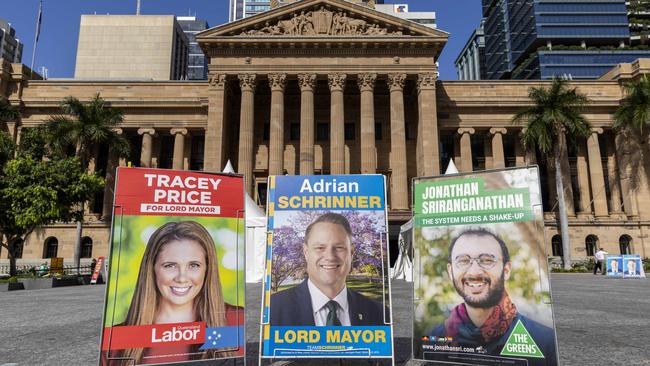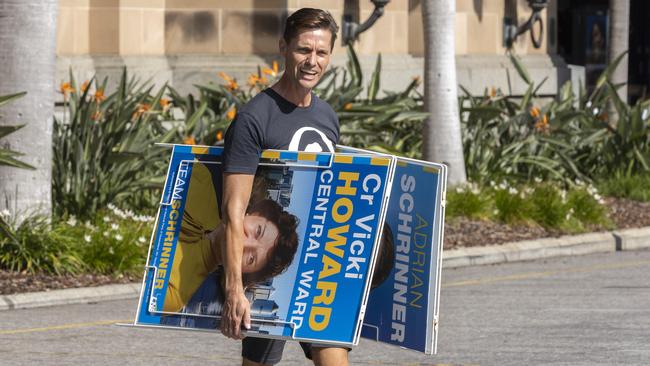Brisbane Council Election 2024 guide: Candidates, party promises, preference voting
Voting has opened for the Brisbane City Council elections. We’ve put together a full guide of the candidates who are running as well as explaining how preference voting works. SEE THE LIST.

Brisbane City
Don't miss out on the headlines from Brisbane City. Followed categories will be added to My News.
Voting has opened for the Brisbane City Council elections. We’ve put together a full guide of the candidates who are running as well as explaining how preference voting works.
Labor’s Tracey Price and the Greens Jonathan Sriranganathan will challenge Adrian Schrinner in his top spot as Brisbane’s Lord Mayor, with Labor and the Greens releasing a full list of candidates to fight for each of the 26 council wards.
While no official deal has been announced, both the Greens and Labor have confirmed they will recommend preference orders to voters.
WHERE TO VOTE: Every polling booth - search the interactive
ROADS AND TRANSPORT: What every party said
HOUSING AND DEVELOPMENT: What every party said
ALL LIBERAL, LABOR AND GREENS CANDIDATES FOR EACH BRISBANE CITY COUNCIL WARD 2024
Listed below are all the candidates from Liberal, labor and Greens political parties and which ward they will be running for ahead of the 2024 Brisbane local Government election in March.
Liberal National Party’s (LNP) “Team Schrinner” had repeatedly raised concerns over a Labor-Greens Coalition and a possible preference deal between the Australian Labor Party and the Greens.
Team Schrinner Campaign spokeswoman Fiona Cunningham accused Labor’s lord mayoral candidate, Tracey Price, of being dishonest about secret negotiations with the Greens.
The LNP is pressing Price to be transparent about potential policies adopted from the Greens, such as the plan to stop funding roads and the $160 million “pay the rent” policy.
The LNP emphasized its commitment to keeping costs down, building better infrastructure, and delivering new lifestyle opportunities.
“Our Labor and Green opponents are focused on doing a dodgy vote-preferencing and power-sharing deal that will cost every Brisbane resident dearly,” Ms Cunningham said.
While Brisbane Mayoral Candidate Tracey Price is yet to confirm any deals between Labor and the Greens, the Party team pledged to “recommend a preference order that allows voters to express their preferences for the city’s leadership”.

While Price remains noncommittal on a deal with the Greens, she asserted during a recent press conference that she hopes to run a council held by a Labor majority.
Labor has criticized the Schrinner administration for a 17 per cent increase in council rates and highlighted $400 million in cuts made in 2023 as part of a budget blowout.
The Labor party will also field candidates in every ward across Brisbane.
“This election is so important to Brisbane’s future,” Ms Price said.
The LNP, Greens, and Labor announced a full list of candidates for all 27 wards, with nominations closing on February 13. LNP Deagon candidate Brock Alexander was disendorsed by the party after the cut off, so he will remain on the ballot paper.
While not confirming preference details,Greens Mayoral candidate Jonathan Sriranganathan said that the Greens would encourage voters to place the LNP last.
The party’s top priorities include making rents and house prices more affordable, improving public and active transport, and holding big developers accountable for local infrastructure costs.
“Our focus is on the issues that matter to voters, such as housing affordability, transportation, and fair treatment for developers,” Mr Sriranganathan said.
Three other people have put their hats into the ring and will run for Brisbane Mayor alongside Mr Schrinner, Ms Price and Mr Sriranganathan: Bruce Tanti, Independent; Gilbert Holmes, Independent; and Clive Brazier, Legalise Cannabis Party.
As the political landscape intensifies in the lead-up to the elections, voters are left to weigh the promises, accusations, and strategic maneuvers of the major parties vying for control of Brisbane’s City Council.
All eligible residents will be required to vote in the 2024 Local Government Election on March, 16.
KEY DATES
Election day - Saturday 8am to 6pm 16 March 2024
Close of return of postal votes - Tuesday 26 March 2024
PREFERENCE VOTING EXPLAINED
In Australian Local Government elections, the preferential voting system, known as the “optional preferential” system, is commonly used. Here’s an overview of how it works:
Candidates and Ballot Papers:
Voters are presented with a list of candidates on the ballot paper. Voters can then choose to vote for one or more candidates by numbering the candidates in order of preference.
Numbering Preferences:
Voters are not required to rank all candidates; they can choose to vote for only one candidate or as many as they prefer.
Preferences are indicated by placing numbers next to the candidates’ names, starting from “1” for the voter’s first choice.
Counting Votes:
The first-preference votes are counted first. If a candidate receives an absolute majority (more than 50 per cent of the first-preference votes), they are declared the winner.
Distribution of Preferences:
If no candidate has an absolute majority after the first count, the candidate with the fewest first-preference votes is eliminated.
The votes for the eliminated candidate are then redistributed to the remaining candidates based on the voters’ next preference.
Iterative Process:
The process of eliminating the candidate with the fewest votes and redistributing preferences continues until one candidate achieves an absolute majority.
Two-Candidate Preferred (TCP):
In some cases, the final result may be determined by comparing the preferences of the top two candidates. This is known as the Two-Candidate Preferred count.
Declaration of Winner:
The candidate who eventually accumulates more than 50% of the votes is declared the winner.
This preferential voting system is designed to ensure that the elected candidate has the broadest possible support among voters. It allows voters to express their preferences beyond their first choice, and it often results in candidates who are more acceptable to a majority of voters rather than those who may have a strong but narrow base of support.
Political parties can strategically use preference voting to maximize their chances of winning in an election.
Here are some ways in which they can employ preference voting to their advantage:
Preference Deals:
Parties can engage in preference deals with other parties or independent candidates. This involves agreeing to exchange preferences in a way that benefits both parties. For example, Party A may agree to give its second preferences to Party B in exchange for Party B giving its second preferences to Party A. These deals can influence the distribution of preferences and potentially help both parties gain more votes.
How-To-Vote Cards:
Parties often distribute how-to-vote cards at polling stations, providing guidance to voters on how to allocate their preferences. These cards can be strategically designed to maximize the chances of the party’s candidates receiving preferences from voters aligned with other parties.
Candidate Placement:
Placement on the ballot paper was decided by a random draw on February 14.
Understanding Voter Behavior:
Parties can analyze past election results and voter behavior to understand preferences. This analysis can help them identify trends and make informed decisions about how to position their candidates and negotiate preference deals.
Targeting Swing Voters:
Parties may focus on appealing to swing voters or voters from other parties who may be more likely to allocate preferences in their favor. Understanding the preferences of different demographic groups allows parties to tailor their campaigns to attract these voters.
Preference Harvesting:
Some parties may engage in a strategy known as “preference harvesting,” where they encourage voters to allocate preferences to them by presenting themselves as a compromise or centrist option that can attract support from a broad range of voters.
Coalitions and Alliances:
Parties may form coalitions or alliances before an election, agreeing to support each other and exchange preferences. This can be particularly effective in a multi-party system where no single party is likely to secure an absolute majority.
It’s important to note that while strategic use of preference voting can be a legitimate part of the electoral process, there can also be debates about the transparency and fairness of certain preference deals. Some argue that such deals may not accurately reflect the preferences of voters and could be used to manipulate election outcomes.
YOUR QUESTIONS ANSWERED
IS VOTING COMPULSORY?
Yes, voting is compulsory. It’s that simple.
By law, it is compulsory for eligible Australian citizens, aged 18 or older, to vote at Queensland state elections, council elections, and state referendums.
WHAT HAPPENS IF I DON’T VOTE?
After every election, the Electoral Commission Queensland checks its records. If they believe you did not vote, you will receive an ‘apparent failure to vote’ notice, which gives you the opportunity to say whether you did or didn’t vote, and why you didn’t vote.
The options at this stage are to provide a valid and sufficient reason for not voting, tell the ECQ that you did vote and provide details, or receive a fine.
If you don’t respond to the apparent failure to vote notice, you will receive an infringement notice. The full penalty for not voting is $154.80, but if you finalise this matter by a certain due date, you will only have to pay half of this - $77.40.
If the fine is not paid, you may be referred to the State Penalties Enforcement Registry (SPER) for further action and additional charges may apply.
HOW CAN I VOTE?
There are five different methods available.
Postal Vote: Anyone can apply for a postal vote. Local government election applications will close at 7pm on Monday, March 4. If you are registered as a postal voter or live in a full postal council area, your postal voting materials will be automatically sent to you.
Early Vote: This option is also open to everyone, but it is important to check operating dates and times. Early voting will be available at around 170 locations across Queensland from Monday, March 4 to Friday, March 15 - not including the weekend. Remember to bring your maroon voter information card with you for quicker voting. Search for your nearest early voting centre here.
Election Day Vote: The big day is on Saturday, March 16. More than 1000 polling booths will be open across Queensland from 8am to 6pm. Remember to bring your maroon voter information card with you for quicker voting. Search for your nearest polling booth here.
Telephone Vote: To be eligible, applicants must either: need assistance due to an impairment or insufficient literacy level, be physically unable to vote due to an impairment, live more than 20km from a polling station, or be an out-of-state or overseas voter including Defence personnel serving overseas. To register for a telephone vote, call the ECQ on 1300 912 782 once early voting begins on Monday, March 4.
IF I’M OVERSEAS, HOW CAN I VOTE?
There are a number of options to support electors travelling overseas for either a short or extended period of time. You can apply for a postal vote to be sent to your overseas address through the ECQ website, but this application must be submitted by March 4. You can also register for a telephone vote through the ECQ website. You can complete an overseas notification form if you won’t be able to vote while travelling overseas. If you’re travelling indefinitely, you have the option to be removed from the electoral roll while you’re away. But once you return to Australia you’ll need to re-enrol. To be eligible to enrol to vote from overseas, you must be an Australian citizen aged 18 years or older, and intend to return to Australia within six years. Enrolling to vote from overseas is handled by the Australian Electoral Commissionhere.




